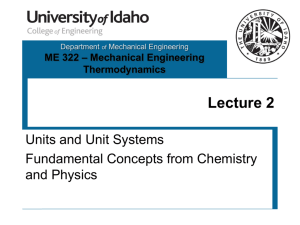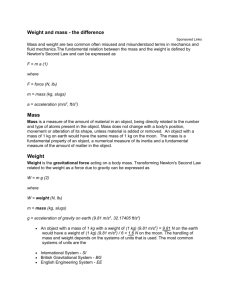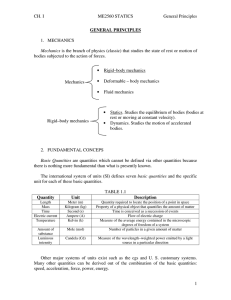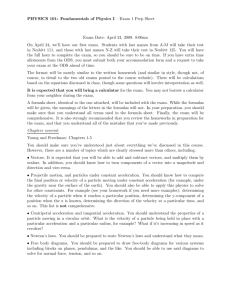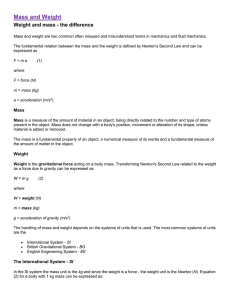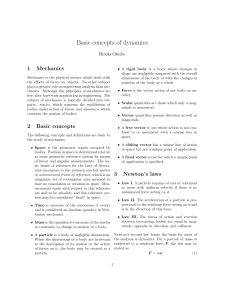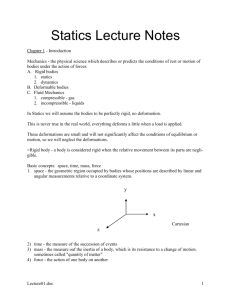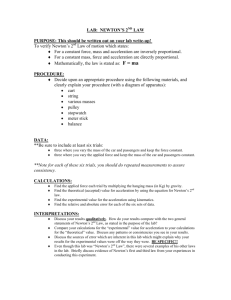Notes # A1
advertisement
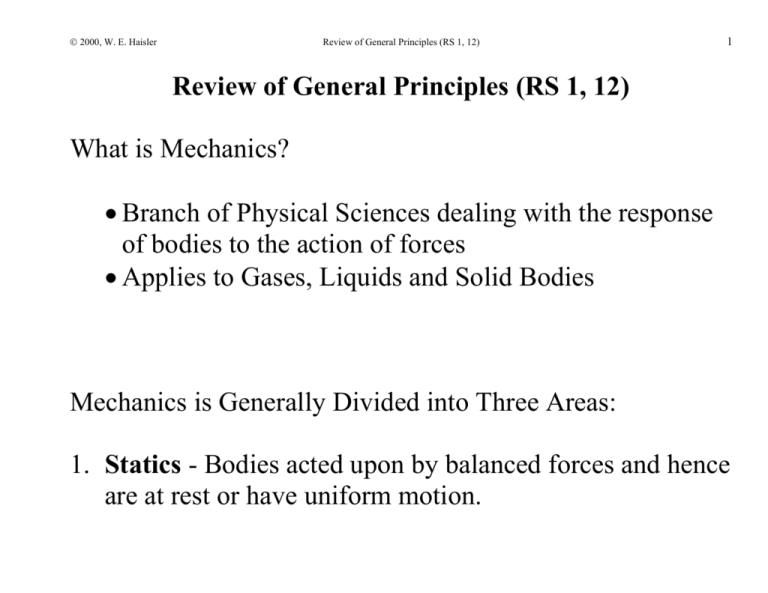
2000, W. E. Haisler Review of General Principles (RS 1, 12) 1 Review of General Principles (RS 1, 12) What is Mechanics? Branch of Physical Sciences dealing with the response of bodies to the action of forces Applies to Gases, Liquids and Solid Bodies Mechanics is Generally Divided into Three Areas: 1. Statics - Bodies acted upon by balanced forces and hence are at rest or have uniform motion. 2000, W. E. Haisler Review of General Principles (RS 1, 12) 2 2. Kinematics - Concerned with the motion of bodies without regard to the manner in which the motion is produced. Sometimes referred to as the geometry of motion. Provides relationships between motion, velocity, acceleration, etc. of the points on a body or the motion of a particle due to physical constraints. 3. Kinetics - Bodies acted upon by unbalanced forces; hence, they have nonuniform or accelerated motions. Sometimes called the dynamics problem. Provides relationships between the motion of a body and the forces and/or moments acting on the body. 2000, W. E. Haisler Review of General Principles (RS 1, 12) 3 Mechanics of Deformable Bodies - The area of Mechanics that deals with internal force distributions and deformations developed in engineering structures when subjected to forces and moments is known as the mechanics of deformable bodies. Also called mechanics of materials. These topics are covered in ENGR 214. Kinetic relationships can be obtained by applying Conservation of Linear and/or Angular Momentum and/or Conservation of Energy. Or, equivalently, by Newton's Laws of Motion. 2000, W. E. Haisler Review of General Principles (RS 1, 12) 4 Newton's 4 Laws Law 1: A particle originally at rest will remain at rest; a particle originally moving with a constant velocity will continue to move with a constant velocity along a straight line, unless the particle is acted on by an unbalanced force. Law 2: When a particle is acted on by an unbalanced force, the particle will be accelerated in the direction of the force; the magnitude of the acceleration will be directly proportional to the force and inversely proportional to the mass of the particle. 2000, W. E. Haisler 5 Review of General Principles (RS 1, 12) Law 3: For every action there is an equal and opposite reaction. The forces of action and reaction between contacting bodies are equal in magnitude, opposite in direction, and collinear. Law 4: Newton's Law of Gravitation: F G m1m2 r2 2000, W. E. Haisler Review of General Principles (RS 1, 12) 6 Unit Systems In mechanics, we use quantities such as mass, force, length, time, velocity, acceleration, etc. when applying conservation principles or Newton's Laws. We can consider some of these to be either fundamental or derived quantities. Fundamental quantities cannot be defined in terms of other physical quantities. Examples are length and time. Derived quantities are defined in terms of other physical quanties. Examples are area, velocity, acceleration, and pressure. 2000, W. E. Haisler Review of General Principles (RS 1, 12) 7 U.S. Customary System (English System) Fundamental quantities: length (foot), force (pound) and time (second). Mass (slug) is a derived quantity such that one slug is the mass that is accelerated one foot per second squared by a force of one pound, i.e., 1 slug = 1 lbf / (1 ft/s2) = 1 lbf s2/ft. Internation System of Units (SI) Fundamental quantities: length (meter), mass (kg) and time (second). Force (Newton) is a derived quantity such that one Newton is the force required to give one kg of mass an acceleration of one meter per second squared, i.e., 1 Newton = 1 kg (1 m/s2) = 1 kg m/s2. 2000, W. E. Haisler 8 Review of General Principles (RS 1, 12) Some Derived Units and their Names/Symbols Force Pressure or stress Energy or work F F / L2 FL kgm / s N / m2 Nm 2 Multiples of SI Units (prefix) 9 giga G 10 mega M 106 3 kilo k 10 Other common symbols (English units) psi = lbf / in2 , psf = lbf / ft 2 kip = 103 lbf Newton (N) Pascal (Pa) Joule (J) 2000, W. E. Haisler 9 Review of General Principles (RS 1, 12) Some Unit Conversions you should memorize! Special SI definitions: Force: 1 N 1 kg m/s2 2 2 Pressure: 1 Pa 1 N/m = 1 kg/(m-s ) Length: 2.54 cm = 1 in Mass: 1 slug = 14.59 kg, 1 lbm = 454 g (or 1 kg = 2.2 lbm ) Force: 1 lbf = 4.448 N (or 1 N = 0.225 lbf ) Pressure: 1 kPa = 0.145 psi (or 1 psi = 6.895 kPa) Volume: 1 ft3 = 7.48 gal 1 qt = 0.946 l, Standard Values: 1 l = 103 cm3 1 atm = 14.7 psi Water weighs: 1 gm/cm3 (or 62.4 lbm/ft3)
